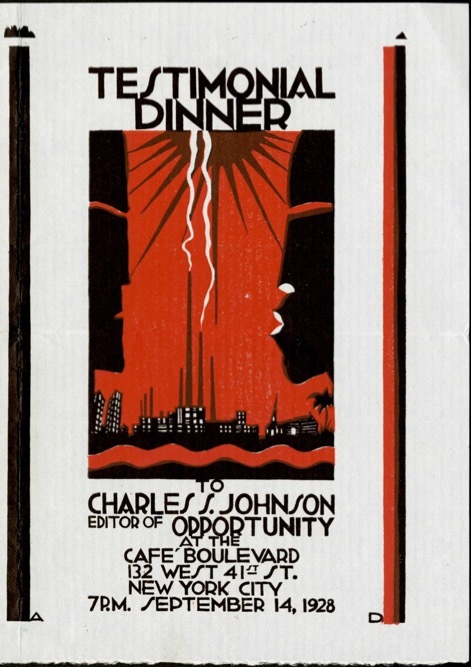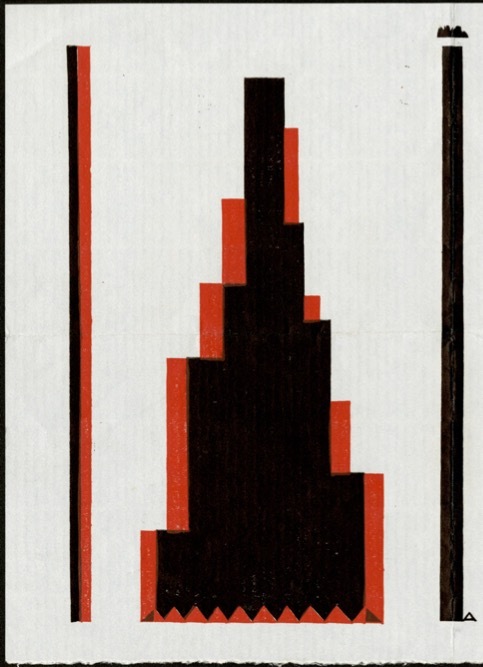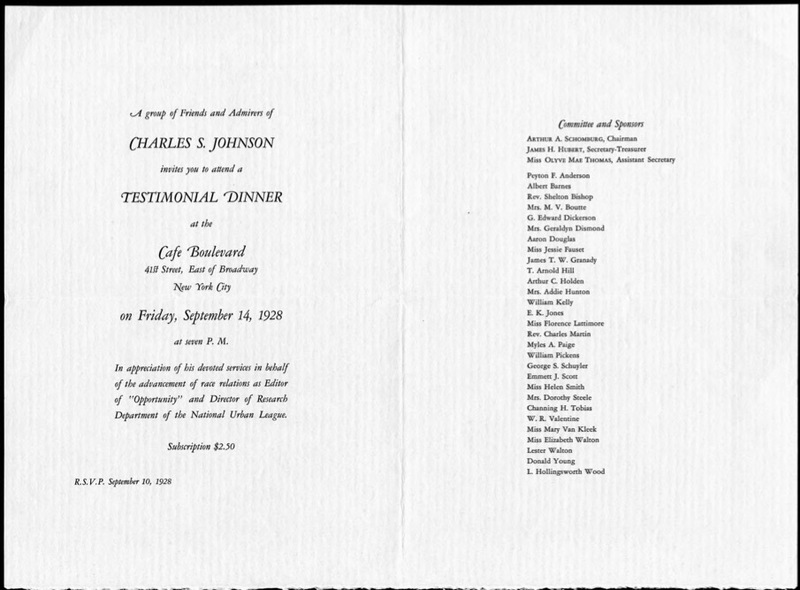-
Title
-
Invitation to Testimonial Dinner to Charles S. Johnson, illustrated by Aaron Douglas.
-
Description
-
Illustration created by Douglas in Philadelphia for an invitation to Testimonial Dinner for Charles S. Johnson in NYC.
-
The invitation honors a dinner for Charles S. Johnson who was a distinguished sociologist and Black leader (1893 - 1956) born in Bristol, Virginia (Howell 2018). The associated artwork was created by the illustrator, Aaron Douglas (1899 - 1979) born in Topeka, Kansas and was widely known as an influential visual artist of the Harlem Renaissance (Aaron Douglas, n.d.). Both circulated among Harlem Renaissance elite from the 1910s through the 1930s, which included intellectuals and artists such as Zora Neale Hurston, W. E. B. DuBois, Alain Locke, Paul Robeson, Duke Ellington and Bessie Smith.
Charles S. Johnson, educated at Virginia Union and the University of Chicago co-authored “The Negro in Chicago: a study of race relations and a 1919 race riot” (1922), which analyzed unrest and conflict. In New York, he led the National Urban League's research arm and founded “Opportunity: A journal of Negro Life” (Wikipedia contributors 2025), that launched many Harlem Renaissance careers, including Langston Hughes and Aaron Douglas, whose illustration is represented here. In 1928, Johnson joined Fisk University, where with support from the Rosenwald Fund, he led groundbreaking studies on Black life in the South, including “The Negro in American Civilization" and "Shadow of the Plantation” (Johnson 1934). Private foundations helped power much of his research including "Growing Up in the Black Belt" (C. Johnson 1941) - Rosenwald Fund and "Into the Mainstream" (C. Johnson 1947) - Carnegie Corporation.
During WWII, Johnson spoke out against segregation, contributing to Arnold Rose’s and Gunnar Myrdal’s “An American Dilemma” and launching Fisk’s influential Race Relations Institutes. In the book “Black Metropolis: A Study of Negro Life in a Northern City” Johnson is credited for pioneering data-driven sociological work that exposed the structural nature of racial inequality (Drake & Cayton 1946). His work supported Thurgood Marshall’s legal fight in the U.S. Supreme Court case of Brown v. Board of Education. Appointed president of Fisk in 1947, Johnson also served UNESCO and advised U.S. presidents. He saw civil rights progress, but was disheartened by slow change in the South. He died leaving a legacy of activism grounded in academic scholarship.
Aaron Douglas worked in factories to fund college, earned a BFA from the University of Nebraska in 1922 and taught art in Kansas City. An avid reader, Douglas followed the Harlem Renaissance through “The Crisis" and "Opportunity: A journal of Negro Life”, edited by W.E.B. Du Bois and Charles S. Johnson. In 1925, deeply inspired by the landmark “Harlem: Mecca of the New Negro” issue of Survey Graphic that was edited by Alain Locke, he moved to New York.
Douglas studied under artist Winold Reiss and published illustrations in "The Crisis" and "Opportunity". He also contributed to Alain Locke’s “The New Negro: An Interpretation”. In 1927, Du Bois made him art critic for “The Crisis”, and James Weldon Johnson commissioned him to illustrate “God’s Trombones”—a piece that defined his style combining African art, cubism, and Art Deco.
His success led to mural commissions, including one at Fisk University and a four-part mural for the 1936 Texas Centennial in Dallas (Powell 1997). After studying in Paris, Douglas returned to New York and later became permanent faculty at Fisk in 1940, where he led the art department and mentored student artists (Lewis 1997). He earned a master’s degree from Columbia and remained active in Harlem and academic circles until retiring in 1966 (Powell, 1997). Douglas was honored with retrospectives in Topeka and Nashville before his death (Bearden & Henderson 1993).
-
Contributor
-
The Barnes Foundation
-
Date Created
-
1928/09/14
-
Creator
-
Douglas, Aaron
-
Rights
-
This work is not in copyright, but commercial uses of this digital representation are limited. For more information, contact reference@barnesfoundation.org and see http://rightsstatements.org/page/NoC-NC/1.0/
-
Identifier
-
AR-ABC-1928-272
-
Language
-
eng
-
Format
-
Image
-
Extent
-
3 images
-
Spatial Coverage
-
Philadelphia, PA
-
Publisher
-
The Barnes Foundation
-
Is Part Of
-
Albert C. Barnes Correspondence, Barnes Foundation Archives
-
Subject
-
Harlem Renaissance
-
Journalism--Objectivity--Public opinion
-
Artist
-
Sociologists
-
Authorship
-
Intellectuals--Political activity
-
Invitation cards--Design






